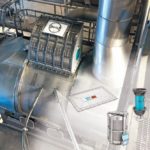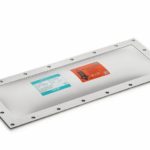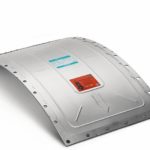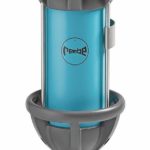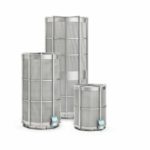Explosion protection involves reducing the effects of an (inevitable) explosion and is the central, most frequently applied explosion safety concept. Certified protective systems are used to safeguard employees, affected plant components and the entire environment. One option is explosion suppression. In this case, the idea is to eliminate the explosion before it can fully form. This is made possible by detectors that use sensors to detect pressure or flames and immediately trigger the extinguishing agent canisters that are also installed in the system. The latter disperse a highly effective extinguishing agent within milliseconds and thus nip the explosion in the bud. If required, an explosion suppression system can also be used for explosion isolation.
Rembe’s Q-Bic extinguishing barrier was developed in strict compliance with the hygiene requirements for spray-drying plants. Thanks to the convex dirt protection cap, neither water nor dust deposits can accumulate on the Q-Bic. The blue-green QXP extinguishing powder prevents cross-contamination and the patented
SJX nozzle ensures optimum application of the extinguishing powder. The Q-Bic is particularly suitable for large pipes attached to dryers and filters or complex shaft geometries such as conveyors and elevators.
Protection of spray dryers and cyclones – a case study
In a production plant for pharmaceuticals, a spray dryer and a
connected cyclone, through which the product is discharged, were to be protected. The most important technical data of the plant at a glance:
- Drying temperature: 90˚C
- Dust specifications: organic dust St1, KSt value: 150 bar*m/s,
Pmax: 8 bar - Lower explosion limit: 255g/m3
- Strength of all system elements: tested Pdesign of minimally 0.3 bar
A safety concept was required that incorporates as few explosion safety products as possible. This is a common requirement; however, it can only be met by considering the plant as a whole and taking all technical specifications into account, as well as the latest research findings.
In the present case, explosion isolation of the spray dryer from the cyclone is not necessary. At first glance, this contradicts the statement that isolation is absolutely necessary to prevent an explosion from propagating. However, scientific evidence shows that decoupling can be dispensed with if a Pred of maximally 0.3 bar is determined for the entire plant, since any hazardous pre-compression in the neighbouring equipment can then be ruled out.
Protection for the spray dryer
VDI guideline 2263, or more precisely sheet 7.1, states that under the following circumstances a reduced volume can be assumed when calculating the necessary vent areas/protective systems:
- No integrated fluid bed
- No recirculation of fine dust into the head of the spray dryer
- The average dust concentration inside the spray dryer is lower than the lower explosion limit of the dust
If these three conditions are met, as in the present case, either a reduced volume of 1/3 of the total volume or the volume of the cone can be assumed. The larger volume must be selected in each case.
For the spray dryer in question, 1/3 of the total volume, i.e. 19.85 m3, was selected.
Observance of VDI guideline 2263, sheet 7.1. allows an additional reduction in addition to the volume, resulting in smaller required vent areas. If it can be assumed that, due to the process, the optimum dust concentration for an explosion will never be present, the protective systems can be designed with a reduced KSt value. Due to the nature of the process – the product is to be dried after all – it has been scientifically proven that a maximum concentration of 250 g/m³ cannot occur in the spray drying system.
The inclusion of the latest research results and current guidelines in the design thus leads to a reduction in the volume to be considered and the KSt value. This in turn allows the creation of a safety concept that is not only safe but also cost-effective. By comparison, without taking these reductions into account, the vent areas for the spray dryer to be protected would have been up to 340 % larger. From the operator’s point of view, this would be over-engineering, because larger relief areas always mean greater effort to modify the respective plant components and, last but not least, higher acquisition costs.
The table shows how the protection system for the spray dryer under consideration might look with and without the described design requirements. For round vessels such as spray dryers, selected flameless explosion venting systems, e. g. the Q-Box, can be installed by means of an adapter flange. Since the entire plant is located inside a building and the operator wanted an explosion protection system with the lowest possible maintenance requirements, flameless venting was chosen in this example.
Protection for the cyclone
For the associated cyclone, the original safety characteristics of the dust in question must be taken into account. Cyclones are usually vented via the vortex finder, which must be included in the design as a vent duct. Therefore, it is also crucial to know the exact dimensions of this plant component. In this particular case, the cyclone is protected by a DN 800 Q-Rohr equipped with an ERO
hygienic explosion vent. By ensuring that the smooth surface of the explosion vent faces the processing area, all hygiene requirements from production are met.
The product discharge area below the cyclone is equipped with an explosion-proof and flame-proof rotary valve.
Risk of tampering with safety systems
Even the highest quality protective systems can only do their job if they are installed correctly and protected against tampering. The risk of tampering is an important issue, and also one that is sometimes ignored.
Recently, Rembe engineers have found indications of such deficiencies increasingly frequent during plant inspections. For example, safety devices are disabled, electronic signalling and warning devices are bridged, mechanical elements are secured with too few fasteners and bolts. The reasons for this are complex and certainly not easy to understand.
Rembe’s protective systems are therefore designed from the ground up to ensure a high degree of in-built safety that is immune to tampering. For example, screw connections are replaced by non-detachable riveted connections; bolts are designed to be self-locking and captive.
This is particularly essential for more complex components such as devices for flameless venting. These systems are typically installed indoors, but always in locations where free venting, e.g. via explosion vents, is not possible. However, if the part responsible for flameless venting fails or has any weak points, this could have devastating consequences for the surrounding area, which would be left defenceless against the flames and pressure of an explosion.
Rembe GmbH Safety + Control, Brilon
Author: Gerrit Fikse
Senior Consultant Explosion Safety,
Global Sales Explosion Safety,
Rembe Safety + Control



